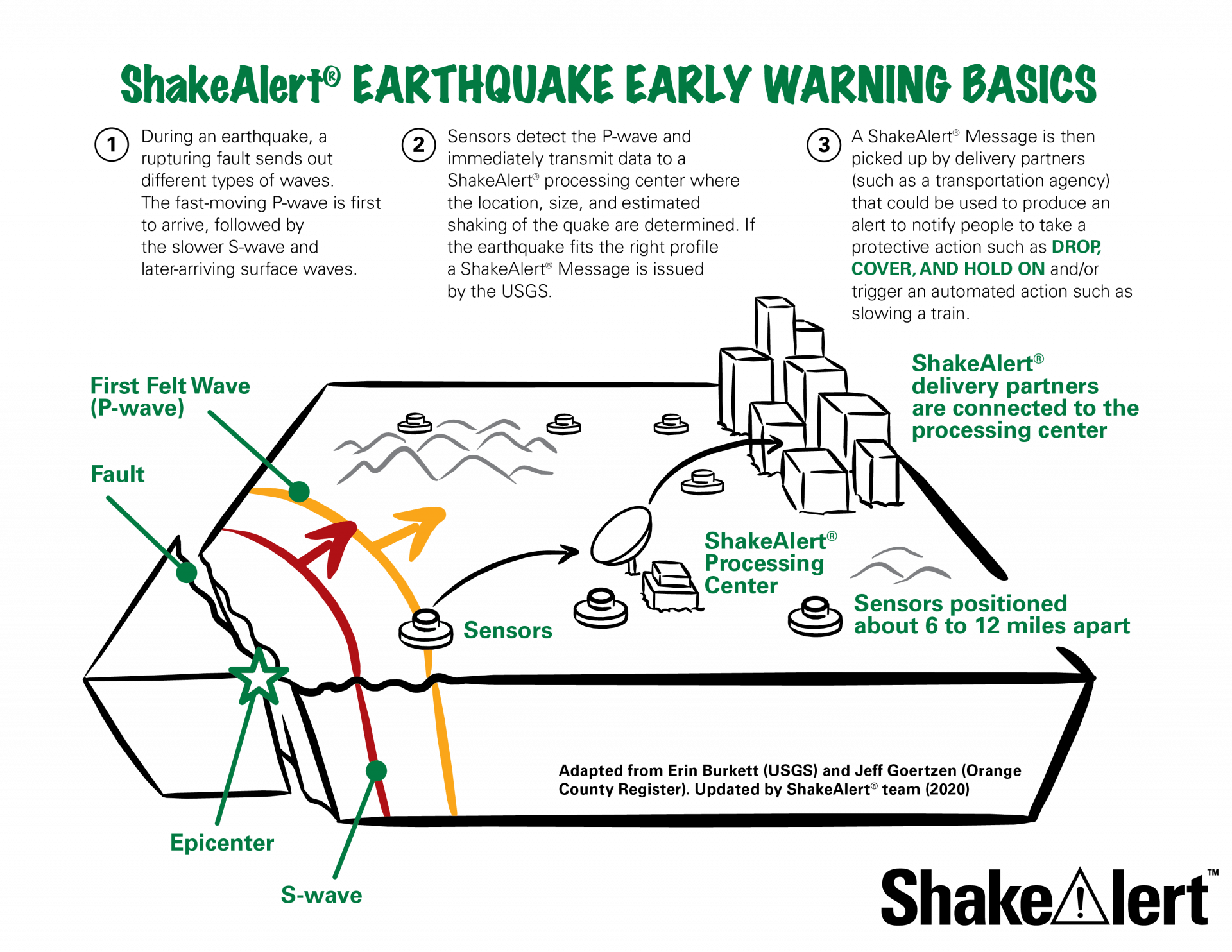ShakeAlert Licensed Operators
Contact a Licensed Vendor of ShakeAlert-Powered Technology to Connect Your Facilities to Earthquake Early Warning


Licensed Operators span multiple industries and sectors, and include private for-profit companies, public entities, and nonprofit organizations. Some Licensed Operators have developed alert delivery systems solely for in-house use. Others act as licensed vendors that sell ShakeAlert-powered products and services to other organizations.
Definitions
USGS-approved ShakeAlert Technical Partners who have demonstrated their ShakeAlert-powered product(s), service(s), and/or applications to end-users and met USGS performance standards (e.g., speed, reliability, technical performance, and education and training).
End-users receive ShakeAlert-powered products or services from LtO Partners. End-users include people who receive these products or services directly (e.g., to their cell phones), as well as organizations that work with an LtO Partner to implement automated “machine-to-machine” actions.
A B2B, or “business-to-business” company provides ShakeAlert-powered products and services to other businesses.
A B2C, or “business-to-consumer,” company sells directly to individual consumers.
Licensed Operators that Provide ShakeAlert-Powered Implementations
Early Warning Labs
Product Name and Type: Cloud Quake
- On-site device
- B2B
Current Implementation Examples:
- Alerting methods include PA systems, speakers, VOIP, voice activated fire alarm boxes, handheld two-way radios
- Open gates and fire station bay doors
- Stop elevators at nearest floor
- Throttle valves
- Train control systems
- Shut down or turn on industrial systems
Location Availability: WA, OR, CA
Website: earlywarninglabs.com
Contact Information: Josh Bashioum (818-588-6001, info@earlywarninglabs.com)
Global Security Systems (GSS) / AlertFM
Product Name and Type: EEWAlert
- On-site device
- B2B and B2C
Current Implementation Examples: Audio and visual alerts delivered via FM Radio to Alert FM voice, text, bluetooth, desk, and wall receivers (including ADA strobe lights)
Location Availability: WA, OR, CA
Website: alertfm.com
Contact: Matthew Straeb, EVP/CTO (mstraeb@gssnet.us)
Kinemetrics
Product Name and Type: OasisPlus Earthquake Response Platform
- Alerting software
- B2B
Current Implementation Examples:
- Deliver audio and visual alerts using via the OasisPlus Earthquake Response Platform
- Provide rapid safety assessments enabling informed decision-making, rapid emergency response, and building occupant safety
Location Availability: WA, OR, CA
Website: oasisplus.kmi.com
Contact: Brandon Parrott (jbp@kmi.com)
RH2 Engineering
Product Name and Type: Advanced Seismic Controller
- On-site device
- B2B
Current Implementation Examples:
- Initiate alarms
- Throttle valves
- Turn off motorized equipment
- De-energize electrical control panels
- Integration with staff alerting systems including WIN911, SMS
Location Availability: WA, OR, CA
Website: rh2.com/risk-and-resilience
Contact:
Washington
- Rick Ballard (425-951-5328)
- Michele Campbell (425-951-5394)
- Taylor Stockton (503-278-5356)
- Bob Willis (503-446-2904)
SkyAlert
Product Name and Type: SkyAlert IoT
- On-site device
- B2B
Current Implementation Examples:
- Stop elevators at nearest floor and prevent manual operation
- Open fire station bay doors
- Stop machinery
- Turn off gas valves
- Alerting methods include strobe lights and audible alerts
Location Availability: WA, OR, CA
Website: skyalertusa.com
Contact: Alvaro Velasco (alvaro@skyalertusa.com)
Valcom
Product Name and Type: Valcom Earthquake Early Warning System
- Alerting software
- B2B
Current Implementation Examples: Audio and visual alerts using intercom, VOIP, or PA speakers (including ADA message boards) via Valcom intercom hardware
Location Availability: WA, OR, CA
Website: valcom.com/earthquake
Contact: Lauren Mason (lmason@valcom.com)
Varius, Inc.
Product Name and Type: ShakeAlarm and ShakeAlarm Lite
- On-site device and remote device
- B2B and B2C
Current Implementation Examples:
- Initiate alarms
- Throttle valves
- Turn off motorized equipment
- De-energize electrical control panels
- Send alerts via PA systems, email, SMS
- Monitor pre- and post-earthquake building condition
- ShakeAlarm Lite is available to schools at no initial cost
Location Availability: WA, OR, CA
Website: variusinc.com/shakealert
Contact Information: Dan Ervin, P.E. (425-269-8479, dan.ervin@variusinc.com)
Licensed Operators that Deliver ShakeAlert-Powered Alerts to the Public via Wireless Devices (Cell Phones)
Product Name and Type: Android Earthquake Alerts
- Operating system alerts
- B2C
Current Implementation Examples: No information provided by licensed operator
Location Availability: WA, OR, CA
Contact: Android Earthquake Alerts Team (android-usgs-external@google.com)
MyShake™
Product Name and Type: MyShake
- Smart phone app
- B2C
Current Implementation Examples:
- A smartphone app that delivers audio and visual alerts to individuals, in partnership with the California Office of Emergency Services.
- Users can view damage and shaking reports submitted by other community members along with detailed event information for quakes around the globe.
Location Availability: WA, OR, CA
Website: myshake.berkeley.edu
Contact: Richard Allen (rallen@berkeley.edu)
Licensed Operators that Use ShakeAlert-Powered Implementations for Limited or Internal Uses Only (Not for Redistribution)
Allen Institute
Product Name and Type: Desktop Alerts (for Allen Institute internal use only)
Current Implementation Examples: ShakeAlert-powered alerts sent to all Institute computers, so users can take protective action accordingly.
Location Availability: WA
Website: alleninstitute.org
Contact: Collin Farrell (colinf@alleninstitute.org)
Everbridge
Product Name and Type: Everbridge Situational Awareness Notifications
- B2B
Current Implementation Examples: Situational awareness notification sent to staff in Public Safety Answering Point (PSAP) facilities that a ShakeAlert Message has been issued by the USGS anywhere in California, Oregon, or Washington. End-users are not warned of imminent shaking or prompted to take a protective action.
Location Availability: Public Safety Answering Points (PSAPs) in OR and CA coordinated by the Oregon Department of Emergency Management and the California Governor’s Office of Emergency Services
Website: everbridge.com
Contact: Everbridge Team (support@everbridge.com)
Metrolink (SCRRA)
Product Name and Type: Commuter Rail Seismic Interface (for Metrolink internal use only)
Current Implementation Examples: Metrolink (SCRRA) uses ShakeAlert data to alert Metrolink’s Positive Train Control (PTC) System that an earthquake is detected.
Location Availability: CA
Website: metrolinktrains.com
Contact: Luis Carrasquero (CarrasqueroL@scrra.net)
San Francisco Bay Area Rapid Transit (BART)
Product Name and Type: BART EEW (for BART internal use only)
Current Implementation Examples: A ShakeAlert-powered BART Train-Control System Application that delivers earthquake early warning controls to BART trains.
Location Availability: CA
Website: bart.gov
Contact: Alvin Tsui (wtsui@bart.gov)
